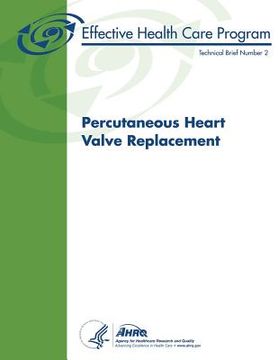Synopsis "Percutaneous Heart Valve Replacement: Technical Brief Number 2"
As the proportion of older adults increases in the U.S. population, the prevalence of degenerative heart valve disease is also increasing. Calcific aortic stenosis (narrowing) and ischemic and degenerative mitral regurgitation (leakage) are the most common valvular disorders in adults aged 70 years and older. For patients with severe valve disease, heart valve replacement involving open heart surgery can improve functional status and quality of life. A variety of conventional mechanical and bioprosthetic heart valves are readily available. However, some individuals are considered too high risk for open heart surgery. These patients may benefit from a less invasive procedure. Percutaneous heart valve replacement is a relatively new interventional procedure involving the insertion of an artificial heart valve using a catheter, rather than through open heart surgery. The portal of entry is typically either via the femoral vein or artery, or directly through the myocardium via the apical region of the heart. An expandable prosthetic heart valve is delivered and deployed at the site of the diseased native valve. The percutaneous heart valve replacement procedure usually takes less time to perform and is less invasive than open heart surgery. The Agency for Healthcare Research and Quality (AHRQ) has commissioned this Technical Brief to: Describe the types of conventional and percutaneous heart valves now in use or in development and their theoretical advantages and disadvantages for different patient populations; Describe the literature comparing various types of conventional heart valves in adults and determine whether a systematic review of this literature is feasible and needed; Describe the literature evaluating percutaneous heart valves in adults, including the patient populations and major outcomes studied to date; Describe implantation techniques for percutaneous heart valves and the factors associated with surgery or setting that may impact outcomes. The research team further clarified and refined the overall research objectives and the key questions. The key questions addressed are as follows: Question 1. What are the different types of heart valves in use and in development (including tissue, mechanical, and percutaneous valves)? a. What are the existing or potential U.S. Food and Drug Administration (FDA) indications for each valve (patient characteristics, etc.)? b. What are the theoretical advantages and disadvantages of different valves for different patient populations? Question 2. From a systematic literature scan of studies on different types of tissue and mechanical valves, describe the types of comparative studies, including basic study design, size of study, length of followup, and outcomes assessed. This literature scan will provide data to determine if a systematic review of this literature is possible and needed, and to provide needed context for understanding the evaluation and development of percutaneous heart valves. Question 3. From a systematic literature scan of studies on different types of percutaneous heart valves, provide a synthesis of the following variables: a. Number for each type of valve. b. Type of studies-comparative and non-comparative randomized controlled trials (RCTs), non-randomized controlled clinical trials, case series, etc. c. Variables associated with surgery (implantation technique), setting, etc. d. Size of studies/length of followup. e. Patient population/concurrent and prior treatments. f. Hemodynamic success rates reported. g. Harms reported. Question 4. What are the variables associated with surgery or setting that may impact outcomes for percutaneous heart valves? a. What are the different implantation techniques (i.e., position of implantation, delivery, and axis techniques)? What is the evidence of success (i.e., absence of narrowing and regurgitation) and harms? i. For percutaneous aortic valves. ii. For percutaneous mitral valves.

